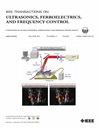Synthesizing Real-Time Ultrasound Images of Muscle Based on Biomechanical Simulation and Conditional Diffusion Network
IF 3
2区 工程技术
Q1 ACOUSTICS
IEEE transactions on ultrasonics, ferroelectrics, and frequency control
Pub Date : 2024-08-26
DOI:10.1109/TUFFC.2024.3445434
引用次数: 0
Abstract
Quantitative muscle function analysis based on ultrasound imaging, has been used for various applications, particularly with recent development of deep learning methods. The nature of speckle noises in ultrasound images poses challenges to accurate and reliable data annotation for supervised learning algorithms. To obtain a large and reliable dataset without manual scanning and labeling, we proposed a synthesizing pipeline to provide synthetic ultrasound datasets of muscle movement with an accurate ground truth, allowing augmenting, training, and evaluating models for different tasks. Our pipeline contained biomechanical simulation using a finite-element method (FEM), an algorithm for reconstructing sparse fascicles, and a diffusion network for ultrasound image generation. With the adjustment of a few parameters, the proposed pipeline can generate a large dataset of real-time ultrasound images with diversity in morphology and pattern. With 3030 ultrasound images generated, we qualitatively and quantitatively verified that the synthetic images closely matched with the in vivo images. In addition, we applied the synthetic dataset to different tasks of muscle analysis. Compared to trained on an unaugmented dataset, a model trained on synthetic one had better cross-dataset performance, which demonstrates the feasibility of synthesizing pipeline to augment model training and avoid overfitting. The results of the regression task show potentials under the conditions that the number of datasets or the accurate label is limited. The proposed synthesizing pipeline can not only be used for muscle-related study but also for other similar study and model development, where sequential images are needed for training.基于生物力学模拟和条件扩散网络合成肌肉的实时超声波图像
基于超声成像的肌肉功能定量分析已被广泛应用于各种领域,特别是随着深度学习方法的发展。超声图像中斑点噪声的性质给监督学习算法准确可靠的数据标注带来了挑战。为了在不进行人工扫描和标记的情况下获得大量可靠的数据集,我们提出了一个合成管道,以提供具有准确地面实况的肌肉运动合成超声数据集,从而可以针对不同任务对模型进行增强、训练和评估。我们的流水线包括使用有限元法进行的生物力学模拟、重建稀疏筋膜的算法以及用于生成超声波图像的扩散网络。只需调整几个参数,提议的管道就能生成大量形态和模式多样的实时超声图像数据集。在生成的 3,030 幅超声图像中,我们定性和定量地验证了合成图像与活体图像的紧密匹配。此外,我们还将合成数据集应用于不同的肌肉分析任务中。与在未增强数据集上训练的模型相比,在合成数据集上训练的模型具有更好的跨数据集性能,这证明了合成管道增强模型训练和避免过度拟合的可行性。在数据集数量或准确标签有限的条件下,回归任务的结果显示了其潜力。建议的合成管道不仅可用于肌肉相关研究,还可用于其他类似研究和模型开发,因为这些研究和开发都需要连续图像进行训练。
本文章由计算机程序翻译,如有差异,请以英文原文为准。
求助全文
约1分钟内获得全文
求助全文
来源期刊
CiteScore
7.70
自引率
16.70%
发文量
583
审稿时长
4.5 months
期刊介绍:
IEEE Transactions on Ultrasonics, Ferroelectrics and Frequency Control includes the theory, technology, materials, and applications relating to: (1) the generation, transmission, and detection of ultrasonic waves and related phenomena; (2) medical ultrasound, including hyperthermia, bioeffects, tissue characterization and imaging; (3) ferroelectric, piezoelectric, and piezomagnetic materials, including crystals, polycrystalline solids, films, polymers, and composites; (4) frequency control, timing and time distribution, including crystal oscillators and other means of classical frequency control, and atomic, molecular and laser frequency control standards. Areas of interest range from fundamental studies to the design and/or applications of devices and systems.

 求助内容:
求助内容: 应助结果提醒方式:
应助结果提醒方式:


